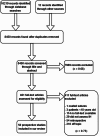Suture Techniques and Materials for Fascial Closure of Abdominal Wall Incisions: A Comprehensive Meta-Analysis
- PMID: 40134474
- PMCID: PMC11932593
- DOI: 10.1097/AS9.0000000000000548
Suture Techniques and Materials for Fascial Closure of Abdominal Wall Incisions: A Comprehensive Meta-Analysis
Abstract
Background: The aim of this systematic review and meta-analysis was to evaluate the effectiveness of different suture materials and techniques for laparotomy closure.
Methods: A literature search was conducted in 3 databases in April 2024. All randomized controlled trials (RCTs) and prospective cohort studies on laparotomy closure were included. The quality of the studies was evaluated using critical appraisal checklists (ROB2 and ROBINS-I). The primary outcome was incisional hernia (IH) formation, and secondary outcomes were fascial dehiscence (FD), combined FD+IH, and surgical site infection (SSI). Meta-analyses were performed using random effects models.
Results: A total of 41 RCTs and 9 prospective cohort studies were included. Meta-analysis revealed no superiority of slowly absorbable sutures over fast-absorbable sutures (5 studies, 1177 patients). Furthermore, no differences between interrupted and continuous suturing were found (14 studies, 5939 patients). Small-bites technique with a slowly absorbable suture was associated with significantly less risk of IH (odds ratio [OR]: 0.44; 95% confidence interval [CI]: 0.30-0.65), combined FD+IH (OR: 0.40; 95% CI: 0.21-0.75), and SSI (OR: 0.70; 95% CI: 0.53-0.91) compared with a large-bites technique (8 studies, 2360 patients). Significant improvements were found for the continuous modified Smead-Jones suturing in the emergency setting (2 studies, 90 patients) and retention-line suturing (1 RCT, 124 patients). Layered closure (6 studies, 2660 patients) or Hughes closure (2 studies, 772 patients) revealed no superiority over mass closure.
Conclusions: Closure of laparotomies in the elective setting using a small-bites technique with slowly absorbable sutures is superior over a large-bites technique. More evidence is needed in the emergency setting, with promising alternatives such as the modified Smead-Jones technique and retention-line suturing.
Keywords: abdominal wound closure techniques; elective surgical procedures; emergencies; hernia; incisional hernia; laparotomy; meta-analysis; suture techniques; sutures; systematic review.
Copyright © 2025 The Author(s). Published by Wolters Kluwer Health, Inc.
Figures






References
-
- Höer J, Lawong G, Klinge U, et al. . [Factors influencing the development of incisional hernia. A retrospective study of 2,983 laparotomy patients over a period of 10 years] Einflussfaktoren der Narbenhernienentstehung. Retrospektive Untersuchung an 2.983 laparotomierten Patienten über einen Zeitraum von 10 Jahren. Chirurg. 2002;73:474–480. - PubMed
-
- Jairam AP, Timmermans L, Eker HH, et al. . Prevention of incisional hernia with prophylactic onlay and sublay mesh reinforcement versus primary suture only in midline laparotomies (PRIMA): 2-year follow-up of a multicentre, double-blind, randomised controlled trial. Lancet. 2017;390:567–576. - PubMed
-
- van Ramshorst GH, Eker HH, Hop WCJ, et al. . Impact of incisional hernia on health-related quality of life and body image: a prospective cohort study. Am J Surg. 2012;204:144–150. - PubMed
-
- Gillion JF, Sanders D, Miserez M, et al. . The economic burden of incisional ventral hernia repair: a multicentric cost analysis. Hernia. 2016;20:819–830. - PubMed
LinkOut - more resources
Full Text Sources
Miscellaneous

